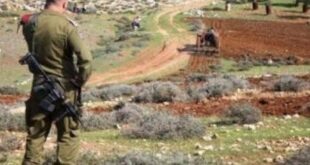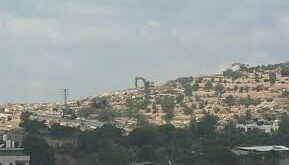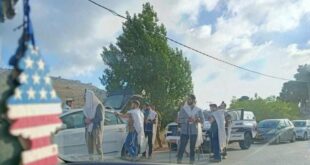By: Madeeha Araj
The National Bureau for defending land and resisting settlements ( nbprs ) stated in its latest weekly report , that neglecting the International Community’s stance that opposes settlement activities, and assures on every occasion that such activities contradicts the International Law, and places heavy restrictions on the chances of progress in the political settlement of the Palestinian-Israeli conflict, and the so-called two-state solution. The occupation authorities recently approved 8 new settlement plans that were officially announced last week and published in the Official Israeli Gazette, to establish and expand settlements in the West Bank, including Jerusalem.
The Civil Administration’s Settlement Subcommittee announced the approval of 8 new settlement plans for the establishment of 1,058 settlement units, public buildings and institutions. According to the decisions of the military government and the details of the announcement of the structural plans, the settlement units were approved according to a detailed plan n 237/3 for the “Eli settlement” built on the lands of the “Al-Sawiya and Qaryut” villages in the site known as “Jabal Al-Rahwat” from the lands of Al-Sawiya and Jabal Al-Khawaniq from the lands of Qariut on an area of 403 dunums to build 628 settlement units. The project was announced on 5/7/2021. On the detailed plan n. 225/3 for the “Ma’ale Michmas Settlement”, which was built on the lands of the village of Deir Dibwan on an area of 800 dunams to establish a new settlement neighborhood, and the detailed plan n. on area of 18.5 acres to build 82 settlement units.
The settlement sub-committee also announced the approval of the detailed plan No. 2/4/2/114 for the settlement of Har Brakhah, which was established on the lands of Burin village in Nablus, on an area of 88.6 dunums, for the establishment of 286 settlement units. Detailed plan n. 169/9 for the “Badawel settlement built on the lands of the Kafr ad-Dik town in the geographical location known as Khirbet al-Hamqa, al-Dair on an area of 4.7 dunums for the establishment of 20 settlement units, and detailed plan n. 1/8/225 for the established “Ma’aleh Mikhmas Settlement” on the lands of Deir Diwan village, on an area of 5.2 dunums, for the establishment of 14 settlement units, and the detailed plan n. 1/3/128 for the “Burkan Settlement”, which was built on the lands of the village of Qarawat Bani Hassan on an area of 10.8 dunums for the establishment of 28 settlement units.
Detailed plan n. 1/4/10/227 for the settlement of “Kfar Adumim” lands of Anata village on an area of 74 dunums for the construction of buildings, public institutions and roads, and an operating area was deposited according to the detailed structural plan n. 1717370/101 under the name “Al-Isawiya operating area” on an area 40 dunums for the establishment of light industrial areas, a park, an engineering facility and a commercial area.
In Jerusalem, settlement operations and Judaization projects continue without stopping. Moshe Leon’s municipality intends to start a settlement project that includes building 2,000 settlement units on the lands of Mount Scopus, as an extension of the French Hill settlement, which perches in the western region of Al-Isawiya, connected with the Sheikh Jarrah Neighborhood. The new neighborhood will be built as part of an agreement signed between the so-called Israel Land Administration and the Hebrew University, whereby construction will be allowed on land that was owned by the university in the French Hill.
The construction of the settlement units will be near the axis of the Judaization light rail, which passes in several areas of central and western Jerusalem, including Shuafat, Malha, and the Baqa’a Neighborhood. At the same time, the municipality’s Local Planning and Building Committee approved last week a plan to move the existing police station near a settlement built on Jabal Mukaber to a new location between al-Sawahrah al-Sharqiya and al-Sawahrah al-Gharbi, which is called “Tel Mitzpeh,” which is a hill on Jabal al-Mukabber near the settlement of Armon Hantsev overlooks the Dead Sea.
On the other hand, according to the Israeli organization “Breaking the Silence”, the Israeli President, Isaac Herzog, last week stormed the Ibrahimi Mosque in Hebron, under heavy guard of the occupation forces, to participate in a ceremony celebrating the so-called “Feast of Lights”. In a speech inside the sanctuary, Herzog claimed that the historical connection of the Jewish people to Hebron, specifically to the Cave of the Macavila ‘the biblical name of the Abrahamic Mosque’ in th the heritage of mothers and fathers, is beyond doubt. Acknowledgment of this connection must rise above all disputes.
Commenting on the visit, the Peace Now Movement said that settlement in Hebron is the ugliest aspect of Israeli control over the West Bank, and it is unimaginable for Herzog, who is supposed to be a unified figure, to choose from all places. To light a candle in a place that has become a stronghold of oppression and violence. In turn, the “Breaking the Silence” organization said that “Herzog’s choice to light the first candle of Hanukkah in the Kahani stronghold is a shameful decision and called on him to read some of the thousands of testimonies of the occupation soldiers who served in Hebron, about the amount of violence and racism that the settlement policy in Hebron produces”
On the level of the so-called hate crimes against a pervasive right-wing nationalist background, well-known international media means reported on the escalation of settlers’ attacks on Palestinian citizens. The Washington newspaper published a report under the title “The escalation of hate crimes campaigns by Israeli settlers against Palestinians in the West Bank, in which it indicated that settlers have significantly increased their attacks during the past months, as violent incidents increased by about 150% in the past two years, according to data that was presented by the occupation army at the meeting of the Ministry of the Army this month, and video clips collected by Israeli human rights organizations showed that the soldiers do not do much to interfere during these events, and in some cases even help in the attacks.
A report by the British newspaper “The Independent” also dealt with the escalation of the Israeli settlers’ attacks against the Palestinians during the season Olive picking, using saws, pruners and shovels. Every year farmers face various threats from settlers, including intimidation, physical attacks, destruction, uprooting and vandalism of their olive trees, and theft of crops and harvest tools. And that, according to the data of the International Committee of the Red Cross, more than 9,300 trees were destroyed in the West Bank, between August 2020 and August of this year.
Settlers Violations against the Palestinians in the Occupied Palestinian Territories
Jeusalem:
- Demolishing a commercial facility in the Abu Deis town under the pretext of being “illegal”, and a plot of land in the Al-Sala’a Neighborhood was bulldozed, claiming that the land was used without a license.
- Forcing the young man, Amir Jalal Rabay’a, 25, to demolish his house in Jabal Mukaber, after the municipality threatened to impose a high fine if he doesn’t self-demolish it.
- Destroying 3 and a half dunums of commercial facility in the Beit Hanina town, in preparation for the seizure of the land and evacuating it for the benefit of the settlers, and a “braksa” for storing building materials in the Anata town, northeast of the governorate.
Hebron:
- Demolishing 3 houses and sheep-barn in the center, east of Masafer Yatta, south of Hebron, under the pretext of not having a permit.
- The archaeological sanctuary of “Yaqin” was stormed in the town of Bani Naim, east of Hebron, and they vandalized and took off iron corners erected by the municipality of Bani Na`im for protection.
Bethlehem:
- Demolishing a retaining wall in the Juwaizah area in the village of Al Walaja, on the pretext of not having a permit. In the town of Nahalin, demolished a house under construction and an agricultural room in the al-Nusba area, to the north of the town, under the same pretext.
- Issuing a notification to seize a land of two and a half dunams in the city of Beit Jala in Bethlehem in the southern West Bank, to expand the road leading to the so-called “tunnels road” and the “Har Homa” settlement, which is built on the lands of Jabal Abu Ghneim in the city of Bethlehem.
Nablus:
- Storming the archaeological site in the Sebastia own, north of Nablus, under the protection of the Israeli occupation army. Settlers attacked the house of Hisham Imad Ahmed Hammoud, adjacent to the “Ihya” settlement, south of the village of Jaloud, damaged the tires of Hammoud’s vehicle, sabotaged its engine, and smashed dozens of trees in the garden of the newly built house. They cut the wires around the garden.
- Notifying to stop construction were delivered to 32 houses, 20 of which are inhabited by 25 families, and a notice to demolish an agricultural “brak” in the town of Qasra, south of the governorate. Three civilians were wounded by rubber-coated metal bullets, and others suffocated with tear gas, when the occupation forces and settlers stormed the Yusef shrine, east of Nablus.
Jordan Valley:
- A massive campaign of intimidation and confiscation in Khirbet al-Ras al-Ahmar, in the northern Jordan Valley, during which 35 families were detained in preparation for their displacement, and their vehicles, tractors and tankers were seized. It also seized 6 agricultural tractors, 5 special vehicles, 5 water tankers, and 3 trailers.
- Imposition 2 fines amounting to 3,978 shekels on the village council of Al-Malih and the citizen Harb Suleiman Afrij Abu Al-Kabbash, 3083 shekels from Khirbet Humsa al-Fouqa from the northern Jordan Valley to recover agricultural equipment and vehicles under the pretext that they are in a closed military area.
 المكتب الوطني للدفاع عن الارض ومقاومة الاستيطان منظمة التحرير الفلسطينية
المكتب الوطني للدفاع عن الارض ومقاومة الاستيطان منظمة التحرير الفلسطينية




